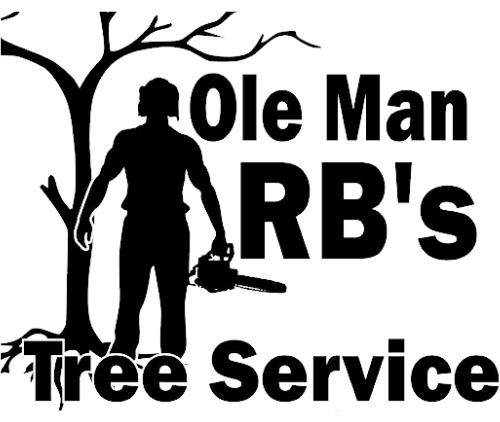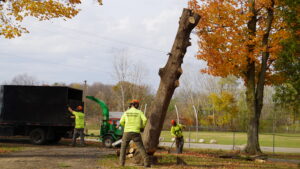
Michigan homeowners know storms can arrive suddenly, bringing heavy winds, pounding rain, and in the colder months, damaging ice. While trees are an essential part of your property’s landscape, a weakened or unstable tree can quickly turn into a dangerous liability when the weather turns severe.
A falling tree doesn’t just threaten your roof, siding, and driveway; it can also cause serious injury, property damage, and costly insurance claims. That’s why it’s critical to recognize the early warning signs that a tree may fall before the next Michigan storm hits.
Below are the top five warning signs every homeowner should look for, along with why professional tree removal in Michigan is often the safest solution.
1. A Noticeable Lean in the Tree
Some trees naturally grow with a slight lean, but a sudden or dramatic tilt is a clear red flag. If your tree seems to be shifting toward your home, driveway, or power lines, it’s a sign that the roots may no longer be holding the tree securely in place.
Key indicators of a dangerous lean include:
- A fresh tilt that wasn’t noticeable before.
- Soil cracking or heaving on one side of the tree.
- Exposed roots on the opposite side.
Once a storm hits, wind pressure can push a leaning tree past the point of no return. If you notice this, don’t wait; call a professional tree removal service immediately.
2. Root Damage or Decay
Roots are the anchor system of your trees. When they’re compromised, the stability of the entire tree is at risk. Unfortunately, root problems often go unnoticed until visible symptoms appear above ground.
Look for these root-related warning signs:
- Mushrooms or fungal growth around the base of the trunk.
- Soft, spongy, or discolored soil near the root zone.
- Cracked sidewalks, driveways, or foundations caused by shifting roots.
In Michigan, wet weather can worsen root rot, making trees more vulnerable during high winds. Professional inspection and, if necessary, tree removal is the safest way to prevent storm-related collapse.
3. Cracks or Splits in the Trunk
A tree’s trunk should be solid and uniform. When large vertical cracks, hollow sections, or splits appear, the structural integrity of the tree is compromised. During a storm, these weak points can act like fault lines, causing the tree to split or snap in half.
Signs to take seriously include:
- Deep cracks that extend into the heartwood of the trunk.
- Bark peeling away in large sections.
- Cavities or hollow spots at the base of the tree.
While some minor issues can be treated, significant trunk damage almost always calls for professional removal to avoid hazardous storm damage.
4. Dead or Falling Branches
Dead branches aren’t just an eyesore; they’re one of the most common warning signs of a failing tree. If large limbs have already fallen or if you notice brittle, leafless branches high in the canopy, your tree could be in decline.
Storm winds easily break off dead branches, turning them into dangerous projectiles that can damage roofs, vehicles, or windows.
Warning signs to watch for include:
- Branches without leaves in spring and summer.
- Bark falling off in patches.
- Numerous dead branches are concentrated on one side of the tree.
In some cases, targeted pruning may save the tree. However, when dead branches appear alongside other structural problems, tree removal may be the only safe option.
5. Signs of Disease or Pest Infestation
Trees weakened by pests or disease are far more likely to fail during a Michigan storm. Insects such as emerald ash borer and diseases like oak wilt or Dutch elm disease can quickly compromise tree health.
Indicators of a diseased or infested tree include:
- Discolored, spotted, or wilting leaves.
- Unexplained thinning of the canopy.
- Small holes in the bark, sawdust piles, or visible insect activity.
- Fungal growth, oozing sap, or strong odors at the trunk base.
Even if the tree doesn’t appear unstable now, a diseased tree will weaken over time. Taking proactive steps, whether through treatment or professional tree removal, can prevent a hazardous collapse later.
Why Professional Tree Removal in Michigan Matters
While DIY trimming may handle small branches, removing a large, compromised tree is not a weekend project. Professional arborists and tree removal experts utilize specialized equipment and adhere to strict safety protocols to minimize the risk of accidents. They also understand Michigan’s soil, weather, and tree species, ensuring safe and efficient removal.
Benefits of hiring a professional tree removal service include:
- Preventing storm-related property damage.
- Protecting your family and neighbors from injury.
- Safely managing trees near power lines, homes, or busy roads.
- Proper disposal of wood, branches, and debris.
When it comes to storm preparation, tree removal is often an investment in peace of mind.
Don’t Wait for the Next Michigan Storm
A storm-damaged tree is more than an inconvenience; it’s a serious risk to your home and safety. By recognizing the signs of instability early, you can take action before disaster strikes.
If you’ve noticed any of these warning signs on your property, contact a trusted tree removal company in Michigan today. Whether it’s tree removal, trimming, or inspection, professional help ensures your yard remains safe, beautiful, and storm-ready year-round.
Michigan’s storm seasons are unpredictable, but your tree care doesn’t have to be. Don’t ignore the warning signs. Schedule a professional inspection and keep your property secure.
Need urgent tree removal in Michigan? Contact Ole Man RB’s Tree Service today for fast, reliable, and professional help before the next storm hits.



Your articles never fail to captivate me. Each one is a testament to your expertise and dedication to your craft. Thank you for sharing your wisdom with the world.
Ivy, Thank you for your kind words.